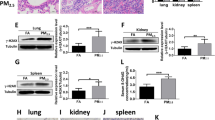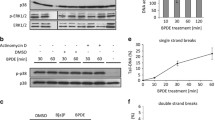Abstract
Environmental chemical exposure often causes DNA damage, which leads to cellular dysfunction and the development of diseases. 4-(Methylnitrosamino)-1-(3-pyridyl)-1-butanone (NNK), a tobacco-specific carcinogen that is known to cause DNA damage, while remains unknown about the underlying mechanism. In this study, simulated doses of NNK exposure in smokers, ranging from 50 to 300 μM, were used to detect the DNA damage effects of NNK in two human bronchial epithelial cells, 16HBE and BEAS-2B. The comet assay revealed increased DNA damage in response to NNK treatment, as measured by increased Olive tail moment (OTM). NNK treatment also led to elevated foci formation and protein expression of γ-H2AX, a DNA damage sensor. Dysregulation of proliferation, cell cycle arrest and apoptosis, was also observed in NNK-treated cells. Furthermore, the most effective dose of NNK (300 μM) was used in subsequent mechanistic studies. A circular RNA circNIPBL was identified to be significantly up-regulated in NNK-treated cells, circNIPBL knockdown successfully alleviated NNK-induced DNA damage and reversed the cellular dysregulation, while circNIPBL overexpression had the opposite effect. Mechanistically, we identified an interaction between circNIPBL and PARP1, a critical enzyme of the base excision repair (BER) pathway. CircNIPBL silencing successfully alleviated the NNK-induced inhibition of BER pathway proteins, including PARP1, XRCC1, PCNA and FEN1, while overexpression of circNIPBL had the opposite effect. In summary, our study shows for the first time that circNIPBL promotes NNK-induced DNA damage and cellular dysfunction through the BER pathway. In addition, our findings reveal the crucial role of epigenetic regulation in carcinogen-induced genetic lesions and further our understanding of environmental carcinogenesis.







Similar content being viewed by others
References
Aggarwal V, Tuli HS, Tania M et al (2020) Molecular mechanisms of action of epigallocatechin gallate in cancer: recent trends and advancement. Semin Cancer Biol. https://doi.org/10.1016/j.semcancer.2020.05.011
Amararathna M, Hoskin DW, Rupasinghe HPV (2020) Anthocyanin-rich haskap (Lonicera caerulea L.) berry extracts reduce nitrosamine-induced DNA damage in human normal lung epithelial cells in vitro. Food Chem Toxicol 141:111404. https://doi.org/10.1016/j.fct.2020.111404
Arjumand W, Asiaf A, Ahmad ST (2018) Noncoding RNAs in DNA damage response: opportunities for cancer therapeutics. Methods Mol Biol 1699:3–21. https://doi.org/10.1007/978-1-4939-7435-1_1
Balbo S, Johnson CS, Kovi RC et al (2014) Carcinogenicity and DNA adduct formation of 4-(methylnitrosamino)-1-(3-pyridyl)-1-butanone and enantiomers of its metabolite 4-(methylnitrosamino)-1-(3-pyridyl)-1-butanol in F-344 rats. Carcinogenesis 35(12):2798–2806. https://doi.org/10.1093/carcin/bgu204
Barnes JL, Zubair M, John K, Poirier MC, Martin FL (2018) Carcinogens and DNA damage. Biochem Soc Trans 46(5):1213–1224. https://doi.org/10.1042/BST20180519
Basu AK (2018) DNA damage, mutagenesis and cancer. Int J Mol Sci. https://doi.org/10.3390/ijms19040970
Brown PJ, Massey TE (2009) In vivo treatment with 4-(methylnitrosamino)-1-(3-pyridyl)-1-butanone (NNK) induces organ-specific alterations in in vitro repair of DNA pyridyloxobutylation. Mutat Res 663(1–2):15–21. https://doi.org/10.1016/j.mrfmmm.2008.12.008
Dietlein F, Reinhardt HC (2014) Molecular pathways: exploiting tumor-specific molecular defects in DNA repair pathways for precision cancer therapy. Clin Cancer Res 20(23):5882–5887. https://doi.org/10.1158/1078-0432.CCR-14-1165
Doukas SG, Vageli DP, Lazopoulos G, Spandidos DA, Sasaki CT, Tsatsakis A (2020) The effect of NNK, A tobacco smoke carcinogen, on the miRNA and mismatch DNA repair expression profiles in lung and head and neck squamous cancer cells. Cells. https://doi.org/10.3390/cells9041031
Du YC, Gu S, Zhou J et al (2006) The dynamic alterations of H2AX complex during DNA repair detected by a proteomic approach reveal the critical roles of Ca(2+)/calmodulin in the ionizing radiation-induced cell cycle arrest. Mol Cell Proteom 5(6):1033–1044. https://doi.org/10.1074/mcp.M500327-MCP200
Evan GI, Vousden KH (2001) Proliferation, cell cycle and apoptosis in cancer. Nature 411(6835):342–348. https://doi.org/10.1038/35077213
George VC, Rupasinghe HPV (2017) Apple flavonoids suppress carcinogen-induced DNA damage in normal human bronchial epithelial cells. Oxid Med Cell Longev 2017:1767198. https://doi.org/10.1155/2017/1767198
Guo H, Liu H, Wu H et al (2019) Nickel carcinogenesis mechanism: DNA damage. Int J Mol Sci. https://doi.org/10.3390/ijms20194690
Haemmig S, Yang D, Sun X et al (2020) Long noncoding RNA SNHG12 integrates a DNA-PK-mediated DNA damage response and vascular senescence. Sci Transl Med 12:531
Han D, Wang Y, Wang Y et al (2020) The tumor-suppressive human circular RNA CircITCH sponges miR-330-5p to ameliorate doxorubicin-induced cardiotoxicity through upregulating SIRT6, survivin, and SERCA2a. Circ Res 127(4):e108–e125. https://doi.org/10.1161/CIRCRESAHA.119.316061
Hua Q, Chen Y, Liu Y et al (2019) Circular RNA 0039411 is involved in neodymium oxide-induced inflammation and antiproliferation in a human bronchial epithelial cell line via sponging miR-93-5p. Toxicol Sci 170(1):69–81. https://doi.org/10.1093/toxsci/kfz074
Hua Q, Liu Y, Li M et al (2021) Tobacco-related exposure upregulates Circ_0035266 to exacerbate inflammatory responses in human bronchial epithelial cells. Toxicol Sci 179(1):70–83. https://doi.org/10.1093/toxsci/kfaa163
Ibuki Y, Shikata M, Toyooka T (2015) gamma-H2AX is a sensitive marker of DNA damage induced by metabolically activated 4-(methylnitrosamino)-1-(3-pyridyl)-1-butanone. Toxicol in Vitro 29(7):1831–1838. https://doi.org/10.1016/j.tiv.2015.07.023
Jackson SP, Bartek J (2009) The DNA-damage response in human biology and disease. Nature 461(7267):1071–1078. https://doi.org/10.1038/nature08467
Jia Y, Li X, Nan A et al (2020) Circular RNA 406961 interacts with ILF2 to regulate PM(2.5)-induced inflammatory responses in human bronchial epithelial cells via activation of STAT3/JNK pathways. Environ Int 141:105755. https://doi.org/10.1016/j.envint.2020.105755
Konstantinou E, Fotopoulou F, Drosos A et al (2018) Tobacco-specific nitrosamines: a literature review. Food Chem Toxicol 118:198–203. https://doi.org/10.1016/j.fct.2018.05.008
La Maestra S, Kisby GE, Micale RT et al (2011) Cigarette smoke induces DNA damage and alters base-excision repair and tau levels in the brain of neonatal mice. Toxicol Sci 123(2):471–479. https://doi.org/10.1093/toxsci/kfr187
Lai J, Yang H, Zhu Y, Ruan M, Huang Y, Zhang Q (2019) MiR-7-5p-mediated downregulation of PARP1 impacts DNA homologous recombination repair and resistance to doxorubicin in small cell lung cancer. BMC Cancer 19(1):602. https://doi.org/10.1186/s12885-019-5798-7
Levine AJ, Oren M (2009) The first 30 years of p53: growing ever more complex. Nat Rev Cancer 9(10):749–758. https://doi.org/10.1038/nrc2723
Li X, Wu J, Zheng J et al (2013) Altered miRNA expression profiles and miR-1a associated with urethane-induced pulmonary carcinogenesis. Toxicol Sci 135(1):63–71. https://doi.org/10.1093/toxsci/kft131
Li X, Yang L, Chen LL (2018) The biogenesis, functions, and challenges of circular RNAs. Mol Cell 71(3):428–442. https://doi.org/10.1016/j.molcel.2018.06.034
Lou J, Hao Y, Lin K et al (2020) Circular RNA CDR1as disrupts the p53/MDM2 complex to inhibit gliomagenesis. Mol Cancer 19(1):138. https://doi.org/10.1186/s12943-020-01253-y
Luo K, Qin Y, Ouyang T et al (2021) let-7c-5p regulates CyclinD1 in fluoride-mediated osteoblast proliferation and activation. Toxicol Sci. https://doi.org/10.1093/toxsci/kfab054
Malakoti F, Alemi F, Younesi S et al (2021) The cross-talk between signaling pathways, noncoding RNAs and DNA damage response: emerging players in cancer progression. DNA Repair (Amst) 98:103036. https://doi.org/10.1016/j.dnarep.2020.103036
Nassour J, Martien S, Martin N et al (2016) Defective DNA single-strand break repair is responsible for senescence and neoplastic escape of epithelial cells. Nat Commun 7:10399. https://doi.org/10.1038/ncomms10399
Pan X, Yuan X, Li X et al (2019) Induction of inflammatory responses in human bronchial epithelial cells by Pb(2+)-containing model PM(2.5) particles via downregulation of a novel long noncoding RNA lnc-PCK1-2:1. Environ Sci Technol 53(8):4566–4578. https://doi.org/10.1021/acs.est.8b06916
Poirier MC (2004) Chemical-induced DNA damage and human cancer risk. Nat Rev Cancer 4(8):630–637. https://doi.org/10.1038/nrc1410
Roos WP, Thomas AD, Kaina B (2016) DNA damage and the balance between survival and death in cancer biology. Nat Rev Cancer 16(1):20–33. https://doi.org/10.1038/nrc.2015.2
Saitoh T, Oda T (2021) DNA damage response in multiple myeloma: the role of the tumor microenvironment. Cancers (basel). https://doi.org/10.3390/cancers13030504
Schiewer MJ, Knudsen KE (2019) DNA damage response in prostate cancer. Cold Spring Harb Perspect Med. https://doi.org/10.1101/cshperspect.a030486
Thomas C, Tulin AV (2013) Poly-ADP-ribose polymerase: machinery for nuclear processes. Mol Asp Med 34(6):1124–1137. https://doi.org/10.1016/j.mam.2013.04.001
Wang H, Song X, Wang Y et al (2020a) CircCNTNAP3-TP53-positive feedback loop suppresses malignant progression of esophageal squamous cell carcinoma. Cell Death Dis 11(11):1010. https://doi.org/10.1038/s41419-020-03217-y
Wang X, Li H, Lu Y, Cheng L (2020b) Circular RNAs in human cancer. Front Oncol 10:577118. https://doi.org/10.3389/fonc.2020.577118
Wu J, Yang T, Li X et al (2013) Alteration of serum miR-206 and miR-133b is associated with lung carcinogenesis induced by 4-(methylnitrosamino)-1-(3-pyridyl)-1-butanone. Toxicol Appl Pharmacol 267(3):238–246. https://doi.org/10.1016/j.taap.2013.01.002
Xiao Z, Yang Z, Xu M et al (2021) The Circ_CARM1 controls cell migration by regulating CTNNBIP1 in anti-benzo[a]pyrene-trans-7,8-dihydrodiol-9,10-epoxide-transformed 16HBE cells. Toxicol Lett 348:40–49. https://doi.org/10.1016/j.toxlet.2021.05.007
Yoshida K, Gowers KHC, Lee-Six H et al (2020) Tobacco smoking and somatic mutations in human bronchial epithelium. Nature 578(7794):266–272. https://doi.org/10.1038/s41586-020-1961-1
Zhang C, Peng G (2015) Non-coding RNAs: an emerging player in DNA damage response. Mutat Res Rev Mutat Res 763:202–211. https://doi.org/10.1016/j.mrrev.2014.11.003
Zhao H, Albino AP, Jorgensen E, Traganos F, Darzynkiewicz Z (2009) DNA damage response induced by tobacco smoke in normal human bronchial epithelial and A549 pulmonary adenocarcinoma cells assessed by laser scanning cytometry. Cytometry A 75(10):840–847. https://doi.org/10.1002/cyto.a.20778
Funding
This study was supported by the National Natural Science Foundation of China (82130095, 91643204, 81872652 to J.Y.), Guangdong Natural Science Foundation (2018B030311019 to J.Y.), Open Research Fund of the Sixth Affiliated Hospital of Guangzhou Medical University, Qingyuan People's Hospital (202011-108 to J.Y.), and the Key Medical Disciplines and Specialties Program of Guangzhou (2021-2023).
Author information
Authors and Affiliations
Contributions
YL: conceptualization, methodology, data curation, validation, visualization, writing—original draft. QH: conceptualization, investigation, writing—original draft. ML: validation, methodology. XL: validation, methodology. WC: methodology. HZ: methodology. QD: methodology. CS: software, formal analysis. YL: investigation. YJ: resources, supervision, writing—review and editing, project administration, funding acquisition.
Corresponding author
Ethics declarations
Conflict of interest
The authors declare that they have no known competing financial interests or personal relationships that could have appeared to influence the work reported in this paper.
Additional information
Publisher's Note
Springer Nature remains neutral with regard to jurisdictional claims in published maps and institutional affiliations.
Supplementary Information
Below is the link to the electronic supplementary material.
Rights and permissions
About this article
Cite this article
Liu, Y., Hua, Q., Li, M. et al. Circular RNA circNIPBL promotes NNK-induced DNA damage in bronchial epithelial cells via the base excision repair pathway. Arch Toxicol 96, 2049–2065 (2022). https://doi.org/10.1007/s00204-022-03297-z
Received:
Accepted:
Published:
Issue Date:
DOI: https://doi.org/10.1007/s00204-022-03297-z




